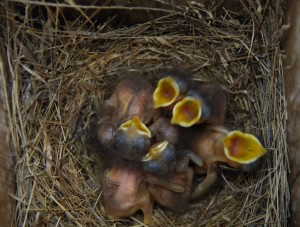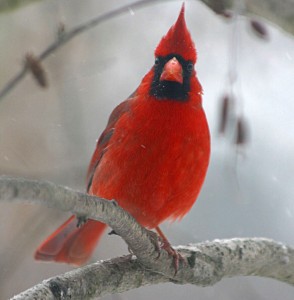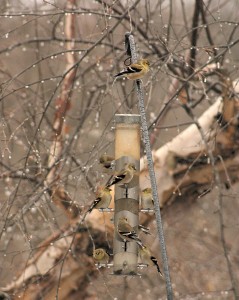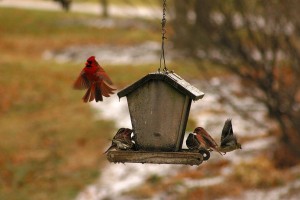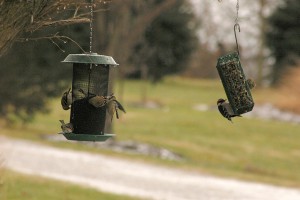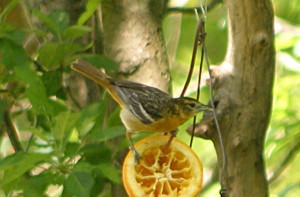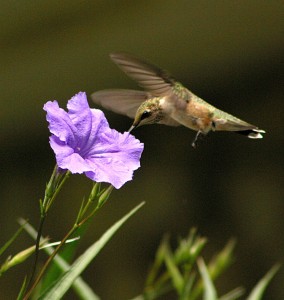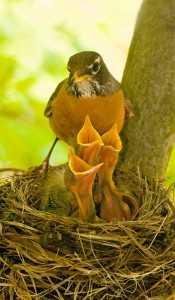Bird Feeding Stations
Got Food?
As winter winds howl across our bluff lands and storms make the days chill and dreary, a popular landscape brightener can be accomplished by adding a bird feeding station that brings nature closer to you. Backyard bird feeding programs are among the most popular nature-hobbies in the United States today, with about 65 million Americans setting tables for birds. Though many of us think of bird feeding only in terms of the pleasure of easy watching, good feeding programs can aid birds.
Several species — cardinals, mockingbirds, and tufted titmice — have greatly increased their year-round range in the north during the last 40 years because of increased food availability, especially in winter when natural food sources run low or are inaccessible due to snow and ice cover. A number of recent scientific studies have shown that several species of seed-eating birds that are able to visit feeders have increased reproductive success in the following spring and summer.
But, while a feeding station can help birds and bring great pleasure, individual
birds can be harmed because a feeding program can increase birds’ susceptibility to disease, predation, and injury. Responsible steps in establishing and maintaining bird feeding stations can reduce these risks.
Birds enjoy eating, you enjoy watching. Place your feeding station in an area that allows you to look but that keeps the birds safe. One way to reduce the danger of bird window strikes is to place your feeders adjacent to windows — the birds won’t hit the window with sufficient force to hurt themselves. Alternately, use mobiles or opaque decals to let birds know that “the air here is solid” or, have screens or place fruit netting outside windows to reduce impact and deter birds from flying into the glass.
A wider variety of bird species will be attracted to and will benefit from feeding stations that are habitat friendly. Placing feeders at different levels allows birds to feed in a natural manner. Juncoes, sparrows, towhees and doves generally feed on the ground, while finches, cardinals, chickadees, titmice, woodpeckers, and nuthatches feed in shrubs and trees. Placing platform feeders near the ground, and hanging hopper or tube-style seed feeders and suets several feet above ground makes the table you set for birds similar to nature’s own.
Placing your feeders near shrubs and trees makes your bird diner even more natural and provides cover and escape from predators. The concentration of birds at your feeders may attract the attention of raptors — hawks and owls. These birds, especially Cooper’s Hawk and Sharp-Shinned Hawk, prey upon and consume other birds. Their occasional presence is a natural result of building a habitat friendly feeding station. If a raptor comes to the table you set, consider yourself fortunate, both for witnessing a thrilling part of nature and in knowing that your feeding program has become an extension of the natural habitat. If, however, a raptor becomes a too-frequent visitor — perhaps because vegetative cover is insufficient and makes the hunt too easy — simply stop feeding birds for a period of time and the raptor will seek food elsewhere. Don’t try to harass, trap, or harm any bird of prey for they all are protected by law and they all play important roles in the natural community.
Cats, however, are a different kind of predatory threat. Free-roaming domestic and feral cats kill hundreds of millions of birds and small mammals each year in
the U.S. Even the most well-tended and well-fed cats hunt for pleasure and are especially dangerous to birds during the breeding season when many nest on or near the ground; nearly all newly fledged birds fly very little and most spend several days on the ground near their former nest sites as the parent birds continue to care for and feed them. Collar bells for cats are not effective. Responsible pet owners keep their cats indoors, keeping wildlife safe, and keeping pets safe from traffic, disease, and other animals. If you cannot eliminate free-roaming cats from your area, don’t attract birds through feeding programs or by providing nesting boxes.
Because your feeding station concentrates birds, the area under your feeders can quickly become a mess of spilled seed, seed hulls and bird droppings. Your feeders, too, can trap and retain moisture allowing seed to become moldy. Diseases like salmonella and avian eye disease as well as parasitic worms all can be passed quickly from bird-to-bird under unsanitary feeding conditions. Seed and suet feeders should have a monthly washing and a brief soaking in a solution of nine parts water and one part chlorine bleach.
Feeder cleaning day is also a good time to rake-up and remove the waste under
your feeding station. While some birds will eat seed from the ground, allowing seed and waste to accumulate for long periods results in contamination from bird droppings and will attract rodent pests.
Seed for bird feeding should be stored in metal containers with tightly closing lids to prevent access by squirrels, rodents and raccoons. Seed containers are best stored in a cool, dry location. Damp seed will grow moldy and can be fatal to birds; seed stored for too long in hot conditions will lose both taste and nutritional value.
The seed food most acceptable to the widest number of bird species is black-oil sunflower. High in nutrition and relished by a wide variety of birds, black-oil sunflower is generally available and, as a favorite seed, is among the least expensive in terms of dollars spent/bird types attracted, and can be used in a variety of different feeder styles. Additional seed feeds — from peanuts, white-stripe sunflower seed, safflower, cracked millet or corn, and thistle (Niger) — can be offered in specialty feeders with food portals designed both for seed size and for the peculiar feeding habits of those species most attracted. Mixtures of seeds, nuts and dried fruits also are available and can increase the different types of birds coming to a feeding station. The cost-conscious feeder looks at labels even more than the price per pound for many inexpensive seed mixes contain milo, wheat and oats which very few birds select; these mixes result in excess wastage and may even reduce the number of birds that visit your feeders.
Suet, or rendered beef fat, attracts many insect-eating birds, and generally is offered in special feeders or net bags. This high-energy food should be offered only during cold weather as suet can become rancid during hot weather. An all-season alternative to suet is peanut butter mixed with cornmeal at the rate of one part peanut butter to four parts cornmeal. Raisins or other dried fruits or sunflower seed may be added to the mix. The dough-like mixture can be stuffed into holes drilled into a small log or packed into a pinecone. Both commercial fat-based suet and peanut butter-cornmeal cakes also can be purchased.
A number of year-round residents rarely eat seed but can be attracted to feeding stations by including fruits. Robins, waxwings, bluebirds and mockingbirds will take currents or raisins that have been moistened in water and placed on a low table or tray feeder. During spring and fall migration orioles and tanagers will gather to eat from halved fresh oranges offered on skewers or spikes near
other feeders. Orioles also will drink from nectar feeders, occasionally poaching from hummingbird feeders. Orioles are very attracted to a combination offering of fruit and sweet, made by offering jelly or jam in small hanging containers.
Birds appreciate water to drink and bathe in. Water can be offered in shallow one- inch deep dishes or, alternately in a slightly deeper dish with a rock or pebbles used to create shallows for smaller birds. Water dishes should be changed daily and wiped down with a bleach solution at least once per week. Fresh water is most important to birds during the winter when cold weather can freeze all natural sources. Birdbath heaters, with a ground-fail interruption circuit (GIFF) can be plugged into outdoor sockets and operated for small cost and great convenience. Glycerin or antifreeze should never be used to keep a bird watering dish from freezing as this is poisonous to birds — and to pets.
And, while enjoying a winter bird feeding program, consider planting a year-round feeding program for adults and their babies. Approximately 96 percent of all terrestrial birds feed their young insects and larvae, or spiders and their kin, which themselves prey mostly on insects.
The birds we enjoy watching and feeding — our Cardinals, Robins, Bluebirds,
Orioles, and Hummingbirds — and the birds we stalk and thrill to hunt — Wild Turkey, Northern Bobwhite — and even the birds we thrill to see hunt — American Kestrels, Red-tailed Hawks — all raise new generations by catching and feeding insects to their young. New bird surveys showing rapid declines in populations of many bird species point to lowered reproductive capacity which may be due to a shortage of insect foods on which to raise healthy broods of baby birds.
The decline in insects is due to the replacement of much of our native vegetation by, first, the expansion of human infrastructure into much that once was available space for wildlife of all sorts. A second, and perhaps even more crucial cause may be the whole scale replacement of native vegetation by nonnative plants. Simply put, native bugs depend on native plants, which produce as much as 35 times as many “bug bites” in comparison to nonnative vegetation.
Adding native plants — trees, shrubs, perennial flowers and grasses — to the area around your feeding station can help transform the dining table you set for the birds into a wild bird (and butterfly, insect, toad, frog, moth….) private nature preserve.
Clifftop, a local nonprofit organization, is focused on preserving and protecting area bluff lands.
Versions of this article appeared in the January 2 2009 edition of the Monroe County Independent and in the January 7 2009 edition of the Suburban Journals Clarion Enterprise. A brochure on this topic was produced by Clifftop, Illinois Audubon Society, and the Kaskaskia Valley Audubon Society and copies, so long as they are available, can be obtained by contacting Clifftop@htc.net
© 2009 all content rights reserved, Clifftop NFP.
Comments are currently closed.

